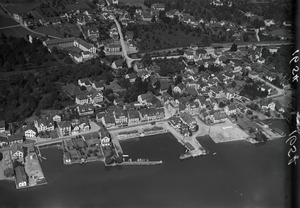Stäfa facts for kids
Quick facts for kids
Stäfa
|
||
|---|---|---|
 |
||
|
||
| Country | Switzerland | |
| Canton | Zurich | |
| District | Meilen | |
| Area | ||
| • Total | 8.59 km2 (3.32 sq mi) | |
| Elevation | 408 m (1,339 ft) | |
| Population
(Dec 2020 )
|
||
| • Total | 14,791 | |
| • Density | 1,721.9/km2 (4,459.7/sq mi) | |
| Postal code |
8712
|
|
| Surrounded by | Freienbach (SZ), Hombrechtikon, Männedorf, Oetwil am See, Richterswil, Wädenswil | |
Stäfa is a town in Switzerland, located in the canton of Zürich. It is part of the Meilen district.
Contents
Exploring Stäfa's Location and History
Stäfa is located on the northern shore of Lake Zürich. It is part of the Pfannenstiel region, close to the town of Rapperswil.
The town covers an area of about 8.6 square kilometers (3.3 square miles). A large part of this land, about 46%, is used for farming. Forests cover almost 19% of the area. About 34% of Stäfa is covered by buildings and roads.
Stäfa got its name from the Scottish Island of Staffa. A monk from Iona named it. In the local language, people call it Stäfa. The town's early history is connected to Einsiedeln Abbey. In 972, King Otto II confirmed that the abbey owned land near the lake, including a place called Steveia (Stäfa).
The villages of Kehlhof and Uerikon are also part of Stäfa. The famous German poet Goethe once stayed overnight in the town.
Who Lives in Stäfa?
Stäfa has a population of about 14,000 people. About 19% of the people living here are from other countries. The population has grown by about 4% in the last five years.
Most people in Stäfa speak German, which is about 88% of the population. Italian is the second most common language, spoken by 3.3% of residents. Albanian is the third most common language.
In 2007, the most popular political party in local elections was the SVP. They received about 33% of the votes. Other popular parties included the SPS and the FDP.
About 20% of Stäfa's population are children and teenagers (0–19 years old). Adults (20–64 years old) make up about 63% of the population. Seniors (over 64 years old) make up about 16%. Most adults in Stäfa, about 80%, have completed higher education. This means they went to a university or a special college.
Jobs and Businesses in Stäfa
Stäfa has a low unemployment rate, which means most people who want to work can find jobs. Many people work in different types of businesses.
- Farming: About 150 people work in farming.
- Manufacturing: Around 1,600 people work in factories and other production jobs.
- Services: Over 2,500 people work in service jobs. These include things like shops, offices, and healthcare.
Many people work full-time, but a good number also work part-time.
Stäfa is home to some important companies. Zürichsee-Zeitung is a daily newspaper based here. Two international high-tech companies, Sonova (which makes hearing aids) and Sensirion (which makes sensors), also have their main offices in Stäfa.
Getting Around Stäfa
Stäfa has good transportation options:
- Trains: Stäfa railway station is served by the S7 train line. Trains run twice an hour to both Zürich and Rapperswil. A trip to Zürich takes about 25 minutes.
- Boats: In summer, you can take a boat from Stäfa to Zürich and Rapperswil. These boats stop at different towns along Lake Zürich. There is also a ferry that runs every hour all year round. It connects Stäfa with Wädenswil on the other side of the lake. The train station and boat dock are only a short walk apart.
- Buses: Local bus services help people get around town and to nearby areas.
What to See in Stäfa
Stäfa is known for its cultural center called Rössli. It is located near the lake. The town is also important for making wine, especially white wine called Riesling.
Famous People from Stäfa
Many interesting people have lived in or come from Stäfa:
- Theodor Eimer (1843–1898): A German zoologist who studied animals.
- Ernst Wiechert (1887–1950): A German teacher, poet, and writer who lived in Stäfa.
- Paul Vogt (1900–1984): A Swiss Protestant pastor and theologian.
- Karl Landolt (1925–2009): A famous Swiss painter known for his oil paintings and prints.
- Matthias Ziegler (born 1955): A Swiss flautist (someone who plays the flute).
- Daniel Jositsch (born 1965): A professor and politician who lives in Stäfa.
- Nick Heidfeld (born 1977): A German professional racing driver who lives in Stäfa.
See also
 In Spanish: Stäfa para niños
In Spanish: Stäfa para niños






